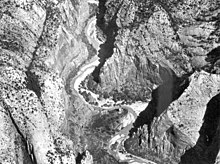
An entrenched river, or entrenched stream is a river or stream that flows in a narrow trench or valley cut into a plain or relatively level upland. Because of lateral erosion streams flowing over gentle slopes over a time develops meandering (snake like pattern) course. Meanders form where gradient is very gentle, for example in floodplain and delta. Meandering is the feature of the middle and final course of the river. But very deep and wide meanders can also be found cutting hard rocks. Such meanders are called incised or entrenched meanders. The exception is that entrenched meanders are formed during the upliftment of land where river is young. They widen and deepen over time and can be found as deep gorges or canyons in hard rock.[1][2] In the case of an entrenched stream or river, it is often presumed that the watercourse has inherited its course by cutting down into bedrock from a pre-existing plain with little modification of the original course. The down-cutting of the river system could be the result not only of tectonic uplift but also of other factors such as river piracy, decrease of load, increase of runoff, extension of the drainage basin, or change in base level such as a fall in sea level.[1][3][4] General, nongeneric terminology for either a river or stream that flows in a narrow trench or valley, for which evidence of a preexisting plain or relatively level upland can be either absent or present is either valley meander or meander valley with the latter term being preferred in literature.[5]
The meanders that form part of either an entrenched river or meander valley are most commonly known as incised meanders.[5] They are commonly classified as either an ingrown meander or an entrenched meander. For a long time, it was argued that ingrown meander occurs when downcutting process is slow and the river can cause lateral erosion, leading to an asymmetric valley. In addition, it was also argued for a long time that an entrenched meander forms when there is a rapid incision of the river bed such that the river does not have the opportunity to erode the lateral side. This leads to symmetrical valleys with a gorge-like appearance. However, more detailed studies have shown the development of ingrown meanders versus entrenched meanders depends on a complex mixture of factors such as bedrock lithology, tectonic activity, and climate.[3][5]
- ^ a b Neuendorf, K.K.E., J.P. Mehl, Jr., and J.A. Jackson, eds., 2005. Glossary of Geology (5th ed.). Alexandria, Virginia, American Geological Institute. 779 pp. ISBN 0-922152-76-4
- ^ Licker, M.D., 2003. McGraw-Hill Dictionary of Environmental Science. McGraw-Hill Companies, Inc. 496 pp. ISBN 0-07-143397-X
- ^ a b Barbour, J.R., 2008. The origin and significance of sinuosity along incising bedrock rivers. Doctoral dissertation, New York: New York, Columbia University. 172 pp. ISBN 0-922152-76-4
- ^ Beckinsale, R.P. and Chorley, R.J., 2003. The History of the Study of Landforms-Volume 3 (Routledge Revivals): Historical and Regional Geomorphology, 1890-1950. Routledge. 524 pp. ISBN 978-0-415568-01-2
- ^ a b c Mangelsdorf, J., Scheurmann, K. and Weiß, F.H., 1990. River Morphology. River Morphology. Series: Springer Series in Physics. Environment. Springer Berlin Heidelberg (Berlin, Heidelberg). ISBN 978-3-642-83779-1